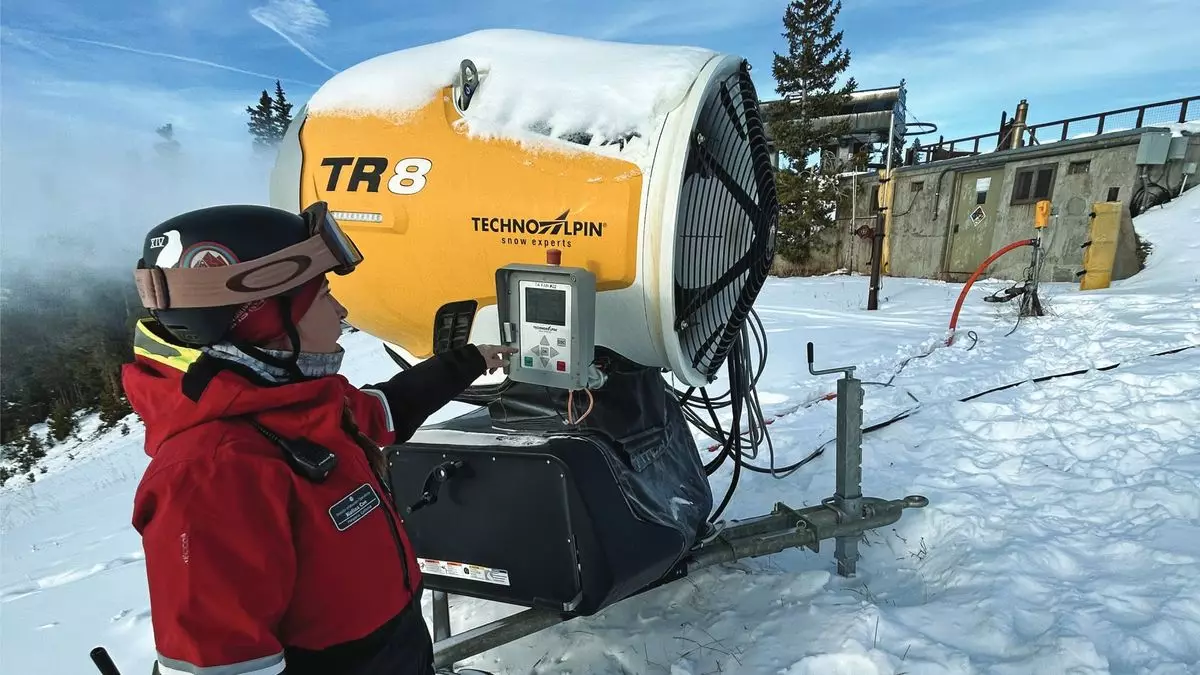As snow-capped mountains begin to beckon winter sports enthusiasts, the anticipation builds for ski season. At Keystone Resort in Colorado, the innovative approach to snowmaking is transforming the preparation for this much-anticipated time of year. On a late autumn morning just before Thanksgiving, an impressive arsenal of snow guns came to life, exemplifying how modern technology can address the challenges faced by ski resorts in a changing climate.
Standing at an altitude of 11,640 feet on Dercum Mountain, an observer can’t help but notice a stunning sight: mobile fan guns and fixed snowmaking machines are hard at work, turning water droplets into a winter wonderland. The underlying technology is captivating. A mobile fan gun, engineered by TechnoAlpin, is strategically positioned at the top of the Mozart slope, creating a flourish of artificial snow that glides down the mountain. What makes this marvel possible? The ambient temperature, a mere 32.9 degrees, is supplemented by a low humidity level of 14%, resulting in favorable conditions for snow production. The wet-bulb temperature registers a cool 21.7 degrees, demonstrating that even marginally chilly weather can yield significant snowfall through advanced technology.
This technological evolution has excited ski area managers such as Kate Schifani and Kolina Coe, who advocate passionately for the potential of snowmaking. In an era where climate unpredictability poses challenges, skiing resorts have increasingly relied on snowmaking to ensure they can open their slopes on a reliable schedule. As Schifani noted, their operation can produce snow efficiently, extending both the duration and the quality of the skiing season.
The economic stakes are high. Keystones’ investment in snowmaking machinery is a strategic move, as ski resorts seek to attract more visitors and maximize revenue during the peak season. Keystone’s 672 snowmaking guns cover approximately 40% of its expansive 3,148 skiable acres, allowing the resort to guarantee conditions for skiers even if nature does not cooperate. This proactive method enables a reliable opening, contrasting sharply with a historical trend wherein ski resorts often struggled to meet early-season demand.
In recent years, there have been impressive advancements in snowmaking capabilities, as witnessed by Keystone’s deployment of 53 modern machines and updated water pipes in 2019. This investment has shifted the average opening date to October 27, a notable improvement from November 8 in preceding years. As a result, alongside neighboring ski areas like Loveland and Arapahoe Basin, Keystone remains a top contender for being among the first mountains to welcome winter sports enthusiasts.
Keystone’s commitment to sustainability is notable. The reality of climate change weighs heavily on the skiing industry, making the quest for eco-friendly operations more urgent than ever. Schifani remarks on this dynamic, emphasizing the importance of using fewer resources while enhancing the quality of produced snow. Such advancements have led Vail Resorts, which owns Keystone, to establish ambitious sustainability goals.
Over the last two fiscal years, Vail Resorts has achieved a remarkable feat: sourcing 100% renewable electricity for its 37 resorts across North America. Additionally, the organization aims for net-zero operations by 2030. Snowmaking processes are being scrutinized closely, with increased automation and sophisticated, data-driven systems that enable optimal snow production. For example, automated interfaces in midmountain operations facilitate dynamic adjustments to snowmaking based on weather conditions, allowing staff to harness short windows of favorable weather effectively.
The measurements of success at Keystone extend beyond mere profitability; there’s also an overarching commitment to preserving the mountain environment. With approximately half of Keystone’s snowmaking stations now automated, the resort is engaged in an ongoing effort to refine this technology. Recent upgrades have included expansions to the Bergman Express lift’s snowmaking capacity, a vital component to enhance the amount of skiers on the slopes.
As Keystone demonstrates, effective snowmaking augments the overall experience for winter enthusiasts and supports the resort’s economic viability. As Schifani aptly states, ensuring consistent opening dates fosters trust and loyalty among skiers. The relationship between a well-prepared ski season and the growth of the industry is one that benefits all parties involved, from resort operators to eager skiers, making the ongoing evolution of snowmaking operations essential.
In essence, Keystone Resort stands as a testament to innovation, sustainability, and resilience, embodying the proactive spirit required to thrive in an ever-changing climate. The future of snowmaking may be highly dependent on advancements and efficiency, but at its core, it is about creating a shared passion for skiing that can be enjoyed for generations to come.

